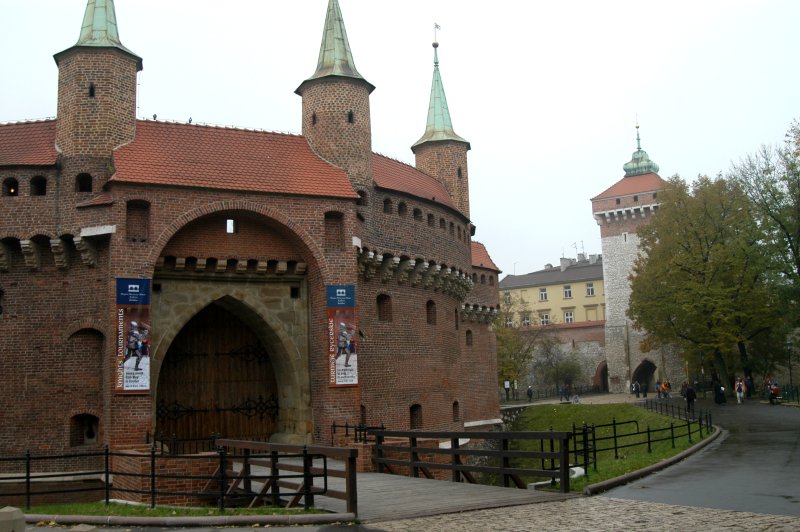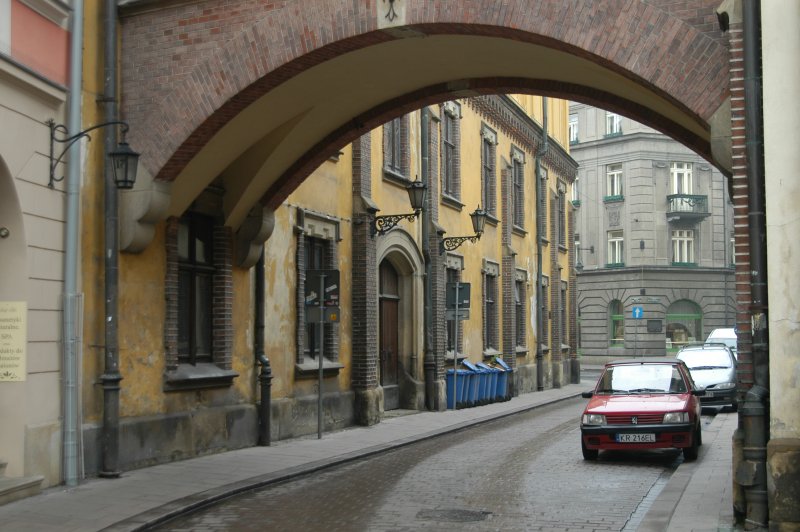|
|
|
To Poland -
my raison d'etre
In truth, I had been wanting
to visit Poland for some time. In 2007, at the Lorelei Rock Festival in
Germany, I had seen English band Pendragon in concert for the first time.
I had been aware of some of the music their keyboardist, Clive Nolan, had
created in collaboration with Oliver Wakeman, tending towards a rock opera /
rock musical style. One such work was a musical adaptation of Sir Arthur Conan Doyle's The
Hound of the Baskervilles. Now in 2007, in partnership
with Agnieszka Swita, Clive Nolan had been
composing and arranging the music to project She, based on a novel penned by Henry
Rider Haggard in 1887. Though not a huge fan of musicals, I thought it was worth a shot
nonetheless. Just the excuse
I needed to pay this country a visit. I ordered my tickets and
with suggestions from a few folk working at Xerox, notably Kamil Leonuik, I
planned an itinerary, soon coming to the realisation that four days and a
bit wasn't going to be long enough. I had secured bookings for Wera
Guesthouse in Crakow, Villa Slimak in Zakopane, Poland's premier winter ski
resort, and Camponile Hotel in Katowice, an industrial city, where the
concert was being staged, at the Wyspianski Theatre, also referred to
as the Śląski (Silesian) Theatr . I would
have to leave visits to the Wieliczka salt Mine and Auschwitz concentration
camp for another day. Not wishing to detract from the importance of the
latter, I felt the need for invigoration from the fresh air of the
countryside and the mountains. I even harboured ambitions of tackling Mt
Giewont at 1894 metres above sea level, only to discover later that this was
out of the question. |
| |
|
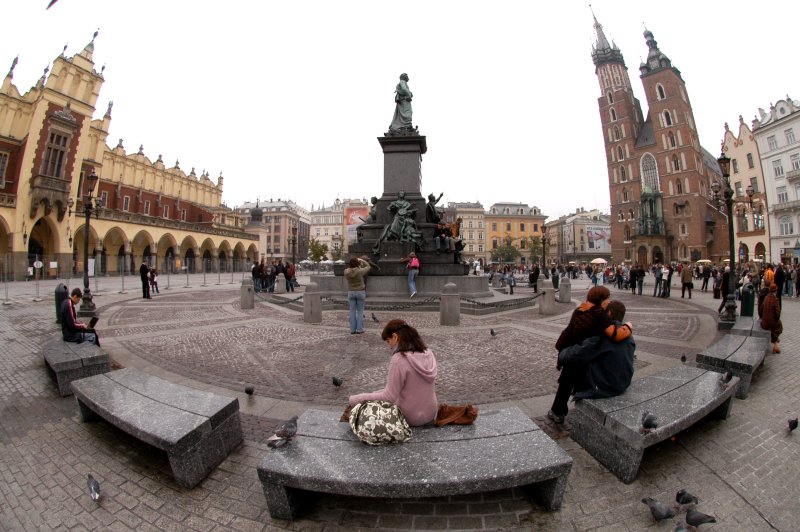 |
|
Crakow main square with the Cloth
Hall,
the Adam Mickiewicz statue
and St Mary's Church. |
|
| |
|
Arrival in Crakow
My late neighbour saw me en
route and offered a lift to Royston station. Maintenance schedules on
the rail network, the norm at weekends, meant bus trips to Cambridge (09h20
from Royston) and a 10h18 connection coinciding with train times, to
Stansted, arriving just on the 2 hour before departure mark quite
comfortably. I checked in quickly, my rucksack weighing only 11 kg. Time for
a coffee and sandwich. I changed £100, though with some difficulty, as my
credit card required extensive checks, largely due to the fact that I had
recently paid for my end of the year ticket to Cape Town. It was a pleasant
flight, made even more so by the friendly, gorgeous Wizz Air air hostesses.
My scheduled time of arrival was 16h35. A rasta reggae band caused a slight
delay upon arrival at customs, local officers perhaps suspicious of them
carrying contraband. I managed to secure a place on the Wizz Ait mini-bus
transport to Crakow via Katowice at a cost of 50zl, about £10. I made a
mental note as to the location of the drop-off in Katowice for future
purposes. How indeed, does one attempt to remember street names like
Juliusza Slowakiego and Piotra Skargi? Darkness had descended and soon we
were on the highway, arriving at Crakow bus station, located just behind the
railway station. Only with the help of my DK guide book was I able to
ascertain, upon leaving the station, that I was in fact heading in the wrong
direction down Topolowa. I altered my approach towards the town centre down
Lubicz and Westerplatte, crossing via a metal bridge en route. A left-turn
at Miko Lajska and adjacent to a park led me comfortably to sw. Krzyza and
the Wear Hostel. I was quite exhausted at this stage. |
| |
|
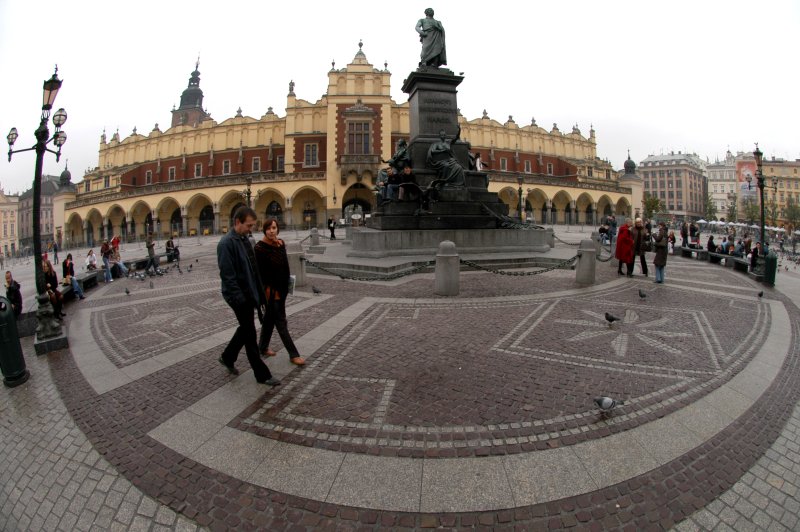 |
|
The Cloth Hall and the statue
of Adam Mickiewicz, Poland's greatest bard and a serial
philanderer - a regular meeting place.
The statue is a copy, the original destroyed by the Nazis. |
|
| |
|
Wera Guesthouse - sharing with the dog
No sooner had I arrived and
introduced myself, when the proprietress began to apologize profusely,
claiming that she had made a mistake by letting the room to someone else, a
friend. perhaps I should have paid more attention to the comment left on
their website by "Unhappy in Poland" which read: "The location was the only
redeeming factor of this guesthouse. The stay was off to an immediate
bad start when we arrived and our room had been double-booked for the first
night", claiming a scam in the process. She was able to converse in German,
which at least made it somewhat easier to make sense of the shambles that
ensued. And so I was resigned to sharing the first night at least, albeit on
the lounge fold-up bed-cum-couch. The lounge also turned out to be the
hostess's living area, though I was spared the ignominy of having to share
the bed as well. To add to this ludicrous situation, her boyfriend occupied
the couch and the dog made itself at home too. She seemed genuinely
embarrassed. I wasn't impressed to say the least, considering I had paid,
but was also in no mood to go traipsing around Crakow at this stage of the
evening, so I made the most of it and left around 20h00 in search of a
restaurant. |
| |
|
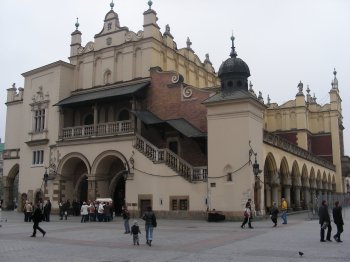 |
|
I didn't have
far to go, so from that point of view at least, I was fortunate. St. Mary's
church was only a block or two away, with the huge main square surrounding
the Cloth Hall, located in the middle. I explored the area and soon found a
place which appealed to me, known as the Jazz Club, in fact a cellar.
Unfortunately, there was no jazz on view that evening. Despite this I
enjoyed a starter of olives and a bowl of Bigos, basically a cabbage stew, a
national dish. It was absolutely delicious. I texted my brother Gordon, as I
often do when travelling abroad. Often he gets out an atlas at home and
attempts to trace my precise location. Still at the main square, I found
myself being "stalked" by a pretty young girl, Agnieska and her friend,
sporting a bandaged, broken finger, and proud of it. She held it up and
proclaimed how drunk she was, well, just a touch. Just two young kids out
having a good time, Agnieska got me to pronounce "goodbye" in Polish, though
it escapes me now. Shaking hands, in the friend's case, with the left,
made them shriek with laughter. Delighted, they were soon gone. Crakow
positively buzzes at night. I arrived back at the hostel. The dog went
berserk. Fortunately, I was exhausted and crashed. despite the fact that
"boyfriend" proved quite a snorer. |
|
The medieval Cloth Hall (the
Sukiennice) which also serves as a market (known as The Rynek) selling
jewellery. There is a gallery on the top floor. |
|
|
Exploring the old town
With the lounge curtains drawn
and the room in virtual darkness, I lost track of time and only surfaced at
09h00 on the Sunday morning. I used the owner's tiny bathroom by mistake,
only later, upon being moved to the room I had actually booked, was I shown
its large adjoining bathroom. She had intended this but not mentioned it. I
was able to vacate to this rather comfortable room, the total cost being
200zl for the two nights. Despite the inconvenience, a more than adequate
breakfast had been provided in the form of rolls and ham, some of which I
saved for later. It was only around 10h30 that I marched off to the old
town, armed with my cameras. Crakow, Poland's second largest city, seemed
perpetually in the mist. This did not discourage Crakovians from coming out.
Mime artists entertained. Kids fed the pigeons. Horse-drawn carts took
tourists for a ride around the square. Services at St Mary's continued all
day, out of bounds to tourists, evidence that Polish Catholics take their
religion seriously. On the hour, each service ends with a blast from one of
eight trumpeters clad in regimental blue and reminded by computer, from the
taller tower. By tradition he breaks off mid-melody to commemorate a 13th
century trumpeter who was shot in the throat while sounding the alarm before
the Mongol attack on the city. The Grand Square is all of 200 metres square,
the largest in Europe. It was laid out in 1257 after the Mongol hordes of
Gengis Khan swept through the city.
"The
Rynek (market) has a great sense of majesty about it. And to lap this up,
there are several vantage points from which one can view the square, which
is precisely why I was stuck there with my camera for hours. Many of the
buildings are very grand, as the aristocracy wanted their palaces here. They
went to town in this respect, lavishing money on their architects". |
|
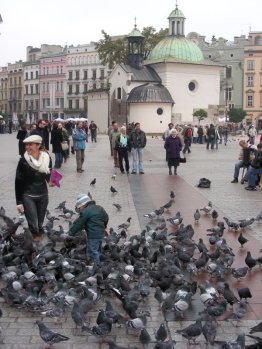 |
|
|
Fun for the kids on the Grand Square
on a Sunday amidst the crazy pigeons, with St Adalbert's church in the
background. |
|
|
|
|
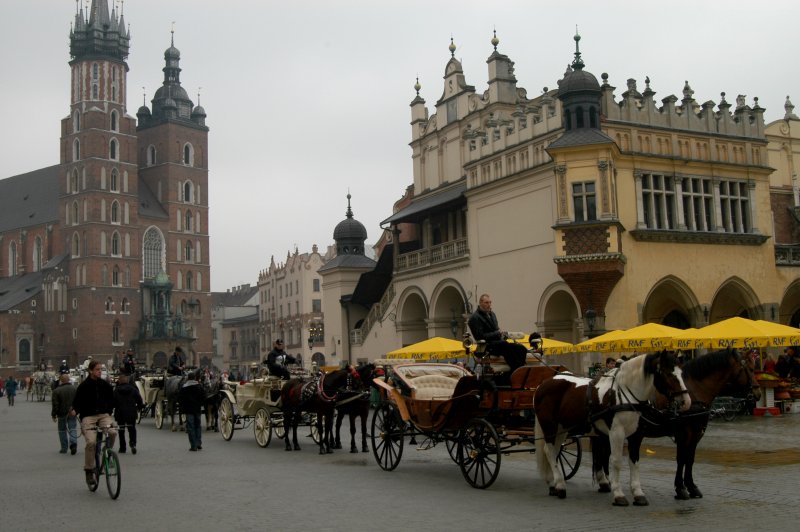 |
|
Take a ride on a Sunday morning
around Crakow Grand Square from the market, near the Cloth Hall and St
Mary's. |
|
|
|
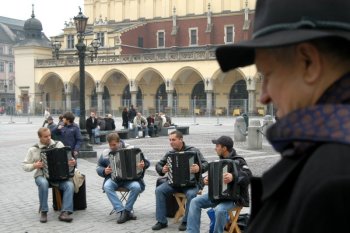 |
|
"During the summer, when the
cafes
bring out their chairs, the entire ring pullulates. It is a good place to
sit and watch the world go by. Indeed, with its buskers and flower-sellers,
its mad
pigeons
and mime-artists, its wonderfully lively and varied architecture, the Market
Square is never a dull place. It is one of the real joys of Crakow". Yet
there is a legend behind the mad pigeons, that dates back to
a Prince of Krakow named Henryk Probius, who harboured ambitions of being
king and reuniting the kingdom that had been divided between 5 sons, of
which he was one. After a witch appeared in the great
Market Square
where the Prince had agreed to meet her, a sharp glance and a swift gesture
of her arm transformed the knights into pigeons.
But while the pigeons have lived on,
Crakovians treat them with such respect. They are indeed no ordinary birds
but the enchanted knights of Henryk Probius, still full of hope and awaiting
the arrival of their Prince with the crown of a King. Crakow is known for
its stag parties, particularly amongst Brits, where it can be arranged for
the groom to be captured in true Russian mafia style.
|
|
|
Buskers play a melody on Crakow
Grand Square, enjoyed by Crakovians and tourists alike. |
|
|
|
|
Believe it or not, a Communism deluxe
tour, lasting about
4 hours, exists. The
arrangement includes transportation in a 1970’s Communist bus or East
German Trabants (for smaller groups), a typical Polish dinner in a
Communist-Era restaurant, a 1980’s live concert during dinner, a short ride
in our crazy, two-stroke Trabant 601 and a vodka tasting with real Polish
workers in our 1970’s exclusive and unchanged apartment.
St Adalbert's church
is the oldest building in the market square in Krakow.
The first stone church was built 1000 years ago and 200 years ago the
present church was built. The baroque dome was added in the 18th Century.
The age of the church is apparent when you look at the church's original
entrance which is now nearly 2 metres below the current level of the square.
St.
Mary's Church, construction of which began in 1355 and lasted 50 years, has
two unequal towers. The church was to have two slim sky-piercing towers to
direct people's eyes toward God's firmament. Two architect brothers who had
recently arrived in Krakow were given the job, and they decided each would
build a tower. They made a bet as to which would be finished first. The
competition soon resulted in hostility between the brothers. The older
brother finished his tower and added a spire with a golden crown. The
celebration by the older brother to which he invited his younger brother
soon resulted in a quarrel during which the older brother fatally stabbed
the younger one. The next day he was tried, sentenced to death, and
executed. No one wanted to finish the shorter tower, so it was covered with
a metal dome. The marketplace and commercial hub of the city has at its
centre the Sukiennice, the medieval cloth hall now of interest mostly to
tourists for its craft items, jewellery, sweaters, and souvenirs. Terrace
cafes are along the sides of the Sukiennice, and flowers are sold under
yellow umbrellas. There is an art gallery on the top level. |
|
|
|
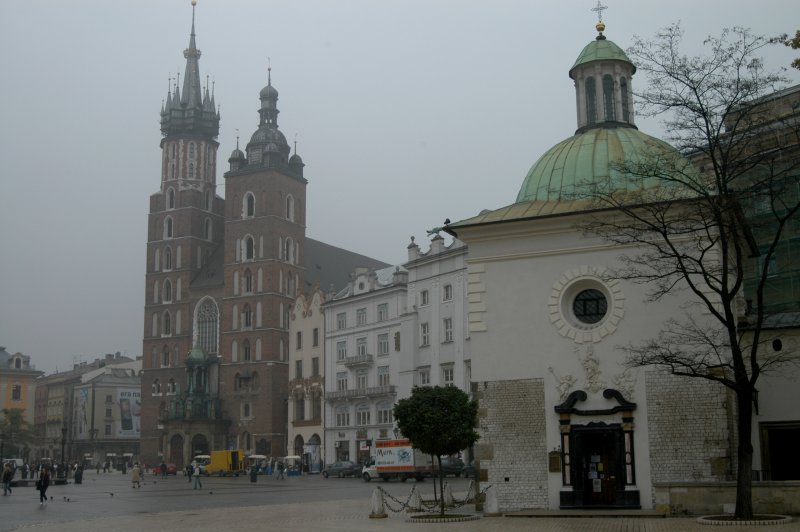 |
|
St Adalbert's church, the oldest in
Crakow, with the two towers of St Mary's, to the rear. |
|
|
|
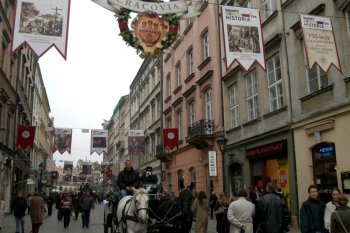 |
|
I wandered down to Wavel Hill
at a leisurely pace and after walking up a cobblestone path, one is
confronted by the cathedral and the castle, whilst overlooking the Wisla
River. A huge open square created 200 years as a parade ground, separates
the two structures. Wavel Hill is where for over 500 years the countrys
rulers lived and governed. The main buildings have not changed much. |
|
 |
|
|
Leaving the Grand Square down
Grodzka towards Wavel Hill; Where to next, as the tram rushes by? |
|
|
|
|
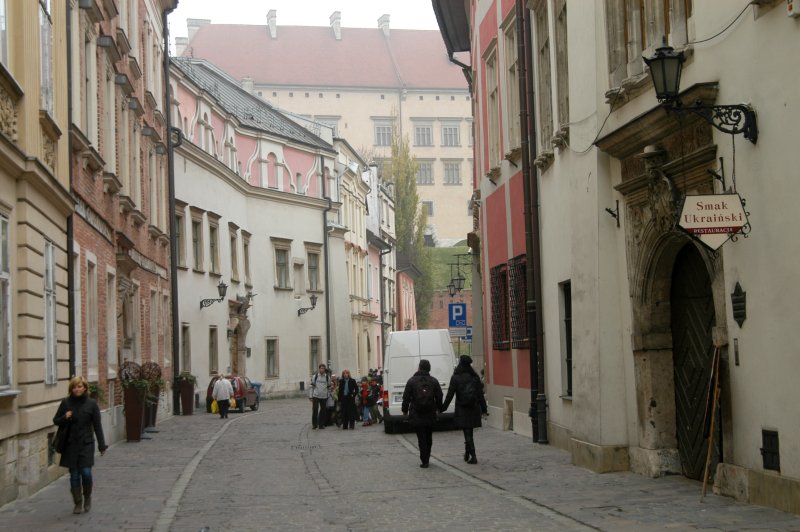 |
|
Approaching Wavel Hill Cathedral and
Castle via Kanonicza, containing the State Rooms and Royal Private
Apartments |
|
|
|
|
Wavel Hill
Prior to entering the
courtyard, scattered with autumn leaves which made for a colourful sight. I
bought a ticket to enter the cathedral from a thickset, stoic looking
elderly nun at the small adjoining building housing the cash desk. Tickets
to visit the castle state rooms had to be purchased from the main tourist
office upon entering the square. A young girl next to the nun smiled and
explained that they were administered separately, though she also found the
procedures complicated. Even after the capital moved to Warsaw, Polish
monarchs continued to be buried at Wavel Cathedral, and many Polish poets
and heroes lie in state in the historic buildings. The first Wavel Cathedral
was built almost a thousand years ago. The brick and sandstone basilica is a
Gothic structure built in the 1300s. The tombs of 41 Polish monarchs are
mostly in side chapels with elaborate decorations. Members of aristocratic
families are also interred here. Wavel Castle was converted from a Gothic
structure into an Italian-style palace in the early 1500s. After much
deterioration and pillage, reconstruction began in the 1880s. During World
War II a German governor used the palace as his private quarters and let
Nazi officers live in the royal apartments. Most of the castle's furniture
and art were taken out of the country for safekeeping when World War II
began. The castle's art
collection includes 136 tapestries, the oldest from the 15th century.
Eighteen have Old Testament scenes, including Noah's Ark and the flood. In
one particular room, sculptured masks adorn the ceiling. Security in both
the cathedral and the palace understandably tight and no photographs were
allowed in either. I had to check in my rucksack at the baggage room and
entered the state rooms via a metal detector at the entrance, not
surprising, since the palace houses the history of Poland. |
|
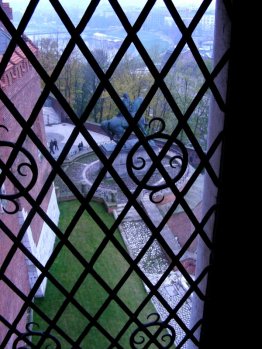 |
|
|
View from the ascent to the
bell-tower in Wavel Hill cathedral. |
|
|
|
|
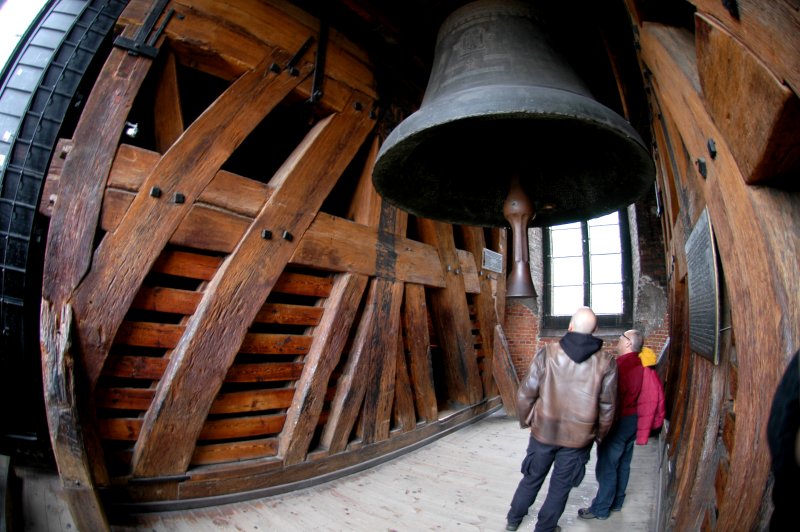 |
|
Wavel Hill cathedral bell-tower. |
|
|
|
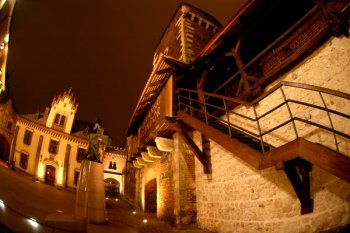 |
|
Although I had spent only
an hour in the state rooms, I emerged to darkness outside.It was time for dinner. Though not in keeping with
traditional Polish food, I settled for a salmon and tuna pizza,
appropriately named an "Oslo", at the local Pizza Express off Kanonicza,
washed down with a glass of red wine. South of Wawel lies Kazimierz,
where the Jewish quarter, which has experienced something of a revival, is
located. According to DK, the Jewish community is now about 6000 strong. A
number of synagogues exist, the oldest being The Old Synagogue. In
appearance this neighbourhood seemed in stark contrast to the town
centre, in an architectural sense as well as the way it had been
maintained, as if the area had escaped restoration. I returned
to the main square for a much-needed coffee at a restaurant adjoining the Cloth Hall.
The delightful arches just outside the restaurant are depicted on the images
page (URL below) using my fish-eye lens. The Barbican, just outside the Florian Gate, is located on the north side of the old town, is a fortified
outpost or gateway - a barbican - it serves as an exhibition centre. |
|
|
Czartoryski Museum in the background
and the Joiners' and Carpenters' Towers. |
|
|
|
|
Jama Michalika
Café
The Florian Gate was built around the 1300's and is one of the best known Gothic
towers in Poland. East of St Florian's gate is the Haberdashers' Towers and
the towers of the Joiners and Carpenters are to the West, the latter
adjoining the Czartoryski Museum, with its art collection assembled in the
1800's.
It was
approaching 11h00 and my interest was waning at this stage. Florianska
Street was still a hive of activity.
Just down from
St Florian's Gate towards the main square lies Jama Michalika
Café,
at 45 Florianska Street. In 1895
Jama Michalika opened a
patisserie near the Market Square. It became very popular with students of
the Fine Arts School, who called the place jama (grotto) for its lack
of windows. Poets, writers and artists soon joined in and in 1905
established the cabaret Zielony Balonik (The Green Balloon).
The greatest artists, actors
and men of letters of the period known as ‘Mloda Polska’ or Young Poland
used to gather here for a talk and amusement over a cup of coffee
or a glass of absinthe. Their caricatures still adorn the walls.
The
performers soon attracted a large audience. Satirical puppet shows soon
became particularly popular. In 1910 Michalik extended and redecorated the
premises, the main room receiving a glass ceiling. Most of the interior
decoration, furniture and stained glass is in the Art Nouveau style. The café
is still an inviting place where customers can enjoy the atmosphere of the
fin de siecle, as well as see the endearing puppet show. The
picturesque hideout seems to keep the time frozen since the days when the
20th century was young and innocent. And for most of Polish intelligentsia
Krakow’s Jama Michalika
café
remains a sanctuary of Bohemian spirit. And so I returned the comfort and
confines of my room. |
|
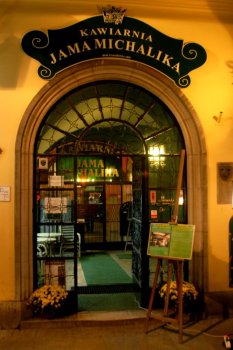 |
|
|
The Art Nouveau Jama Michalika
café,
once the meeting place of students of the Fine Arts School around 1905. |
|
|
|
|
Final hours in Crackow
On the
morning of Monday 29th October, I arranged to keep the room till around
midday, so that I explore the town once more, before my planned departure to
Zakopane in the south of Poland. I wolfed down my breakfast an left around
09h00. Once again an early mist hung still and motionless. I headed down
Kanonicza towards Wavel, until I saw an entrance to a park bathed in the
colours of autumn. I instinctively knew, after some distance, where this
would take me, as the path wound its way around the perimeter of the old
town. It was beautiful. Ultimately I found myself at the Barbican, on
the north side, through the Florian Gate and past Jama Michalika
Café,
where I had been the night before. Back at the
Rynek,
I enquired about buses to Zakopane. Three different companies operated on
the route, each to their own timetable, collectively every half hour,
ensuring that the possibility of my getting there was never in doubt. I drew
cash at a Deutsche Bank, slipped silently into St Mary's for a quick view,
despite church services still being in full swing, finally returning to the
hostel. Gathering my rucksack, I retraced my way back to the station,
picking a far more direct route, being much the wiser as far as the
geography of the place was concerned. A midday bus was about to leave just
as I got there. After boarding, I settled down for the two hour
journey, at a measly cost of 16zl. Soon we had left a congested Crakow and
found ourselves in mountainous terrain as we headed towards the Tatras, the
highest mountains in central Europe. |
|
|
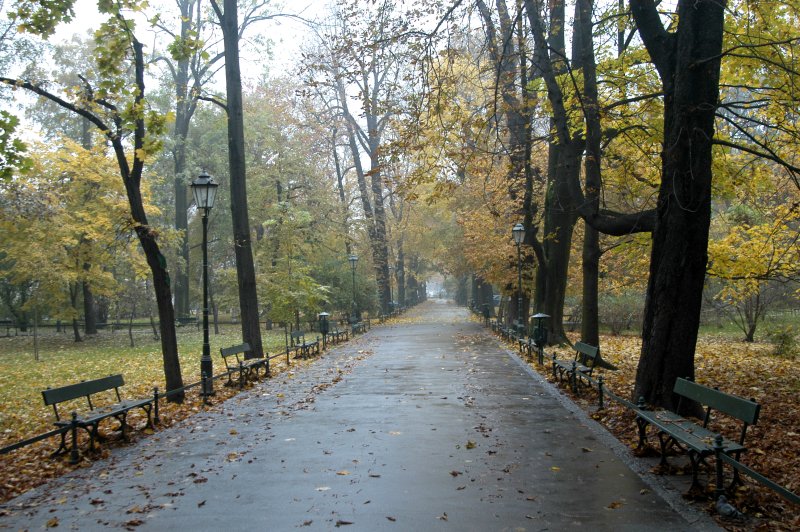 |















